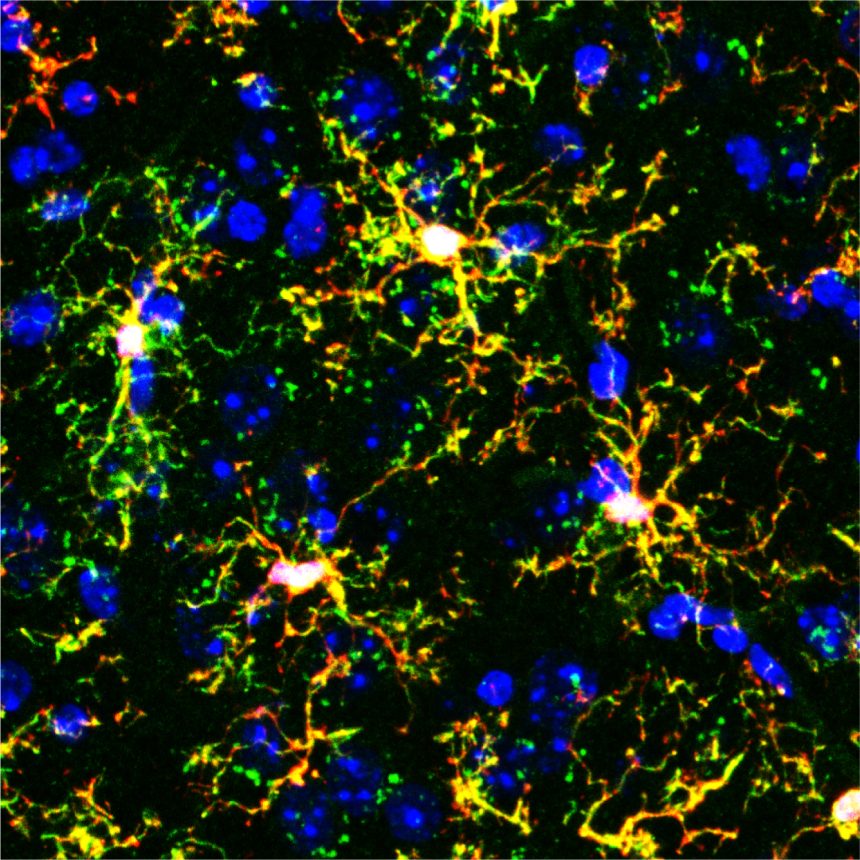Anxiety disorders are some of the most common mental health conditions in America, affecting about one in five people nationwide. But much remains unknown about the roots of anxiety in the brain. Now, research at the University of Utah has identified two surprising groups of brain cells in mice that act as “accelerators” and “brakes” for anxiety.
Unexpectedly, the brain cells that regulate anxiety aren’t neurons, the cells that link together to make circuits and pass signals over long distances in the body. Instead, a kind of immune cell called microglia appears to fundamentally regulate whether mice are anxious or not. One group of microglia spurs anxiety responses; the other group tamps them down.
“This is a paradigm shift,” says Donn Van Deren, PhD, postdoctoral research fellow at the University of Pennsylvania, who did the research as a postdoctoral research fellow in human genetics at University of Utah Health. “It shows that when the brain’s immune system has a defect and is not healthy, it can result in very specific neuropsychiatric disorders.”
The results are published in Molecular Psychiatry.
A complex role for brain immune cells
The researchers had known from earlier experiments that microglial immune cells are important for the regulation of anxiety. But they had found that all microglia seemed to do the same thing. When they interfered with a specific group of microglia, called Hoxb8 microglia, mice started to act anxious. But when the researchers prevented the activity of all microglia at once—including Hoxb8 and non-Hoxb8 microglia—mice behaved normally.
This led the researchers to suspect that the two groups of microglia do opposite things: Hoxb8 microglia prevent anxiety while non-Hoxb8 microglia promote it. But to learn for sure, they needed to see what each group of cells did on their own.
Brakes and accelerators for anxiety
The researchers’ results hinged on an unconventional experiment: transplanting different kinds of microglia brain cells into mice that lack microglia altogether.
The researchers found that non-Hoxb8 microglia act as a gas pedal for anxiety. When researchers transplanted non-Hoxb8 microglia into mice without any other microglia, the mice groomed themselves compulsively and spent less time in open spaces—classic signs of higher anxiety. With only non-Hoxb8 microglia, the accelerator for anxiety was always on, with no brake pedal to keep it in check.
The other kind of microglia, Hoxb8 microglia, act as the brake pedal for anxiety. Mice transplanted with only Hoxb8 microglia weren’t anxious. And, importantly, mice with both kinds of microglia—the gas and the brake—weren’t anxious either. Non-Hoxb8 microglia might be driving the mice towards anxiety, but it was balanced out by the anxiety-preventing activity of Hoxb8 microglia, so the mice did not show anxiety behaviors.
“These two populations of microglia have opposite roles,” explains Mario Capecchi, PhD, distinguished professor of human genetics at University of Utah Health and the senior author on the study. “Together, they set just the right levels of anxiety in response to what is happening in the mouse’s environment.”
Toward better treatments for anxiety disorders
The researchers say that their results could lay the foundations for major advances in how anxiety disorders are understood and ultimately treated. “Humans also have two populations of microglia that function similarly,” Capecchi says. But existing medications for psychiatric conditions almost exclusively focus on neurons.
By finding how other kinds of brain cells can drive anxiety, researchers could develop therapies that focus on these microglia—activating the brakes or weakening the accelerator.
“This knowledge will provide the means for patients who have lost their ability to control their levels of anxiety to regain it,” Capecchi says.
“We’re far from the therapeutic side,” Van Deren cautions, “but in the future, one could probably target very specific immune cell populations in the brain and correct them through pharmacological or immunotherapeutic approaches. This would be a major shift in how to treat neuropsychiatric disorders.”
Source: University of Utah Health
Published on November 14, 2025


